Conference Speaker Ruchika Tulshyan on Finding Advantage in Diversity

Last year we shared a bit about our work to make the Lean Startup Conference intentionally welcoming and inclusive, including and especially to those who are typically underrepresented and under-served in this sector.
This year we are excited and committed to continuing that work, with an accessible venue and robust volunteer and Bootstrap programs that make sure that money isn’t a barrier to attendance. Speaking of, we have attendees arriving from six continents with different backgrounds and perspectives to share. (If you’re reading this in Antarctica, we’d love for you to join us!) Finally, we are bringing you a diverse group of speakers including Ruchika Tulshyan, author of The Diversity Advantage: Fixing Gender Inequality In The Workplace and the founder and CEO of Candour, an inclusion strategy practice.
Our Inclusion and Accessibility Manager, Ragen Chastain, spoke with Ruchika about the vital work that she does, and what we can expect from her talk at the conference this year.
You’ve discussed that your work is informed by being Singaporean, and living in five countries by the age of 23 – can you talk more about what those experiences taught you?
I was raised in, and moved through, multiple cultures throughout my life – Indian, Singaporean, British, American — with friends, educators, and later, colleagues, from all over the world. No doubt in my mind that we have more commonalities than differences; to be seen, heard and valued. When I talk about diversity and inclusion, some people can perceive it as an attack on their good intentions. But when I frame it as collaborating to find ways to ensure that everyone feels valued, welcomed, and like they can bring their whole selves to work, then it becomes a lot more palatable.
I also think it’s important to strive for diversity, equity and inclusion to become a way of life – look for, and actively engage with, points of view that are not represented, rather than always going with the majority. Everyone benefits from it, especially you!
Would you share a bit about the path you took from those early experiences to your current career?
I became a journalist because I was fascinated by stories. I was a business journalist and lucky to be part of newsrooms in some of the most vibrant financial markets in the world; New York, London, Mumbai, and Singapore, to name a few. I then transitioned into tech marketing after moving to Seattle.
Being in the hyper-growth startup industry before concepts like “#Metoo” and “Bro” culture were fully acknowledged meant that I experienced and witnessed many miserable acts of sexism and racism, but I had no language to call it out, which was deeply unsettling to me as a words and stories person. So I quit that field to write a book about how organizations – not women – could lean in to fix gender inequality. My consulting practice since has become a lot more intersectional to now also focus on other types of equity, especially racial equity, at work.
I also am an angel investor actively seeking to fund underestimated entrepreneurs (thank you, Arlan Hamilton!)
How did you get involved with Lean Principles?
Each Spring, I teach a class on multimedia entrepreneurship at Seattle University. When I was planning for the class, I read up on Lean and couldn’t believe how applicable it was to the media industry; one that was rapidly changing, and also truly grappling with diversity challenges that threatened the very work it needed to do to sustain a healthy democracy. Lean made so much sense – we’ve seen tiny startups become the source for news over the behemoths – newsletters, blogs and podcasts started by underestimated entrepreneurs that have outperformed the giants, especially because they’re highlighting and catering to communities traditionally left out of the media. It’s inspiring and also so logical: talking to and learning from your customers is key!
Can you give an example of how Diversity and Inclusion, and Lean Principles can work together?
In my work, I’ve found organization leaders are scared to address Diversity & Inclusion (or wastefully throw money at “check-the-box” solutions)..
For example, many companies don’t realize policies focused on improving gender equality largely only benefit white women – such as negotiation or confidence workshops. They spend thousands of dollars to launch, rather than starting small, collecting feedback from an intersectional group of employees, and learning from that.
When these ideas fail, organizations default to blaming the underrepresented groups, rather than trying to ascertain why didn’t it work, and what would instead. For D&I work to be sustainable and successful, we all have to operate from a frame of intense humility and a growth mindset.
Would you give some examples of the outcomes you help your clients accomplish?
I believe in collecting evidence and acting upon that, taking an intersectional and design-thinking approach. I work with clients to design bespoke evidence- and data-backed solutions to improve diversity in hiring, team culture and inclusion, and most importantly, ways to address personal bias in managers and leaders, which is often deeply connected to inequitable behavior, even among those operating with the best of intentions. I’ll be talking more about this in my session at the conference.
What can we expect from your talk at the conference?
Case studies and data! People say I can be funny, though I have never thought that about myself. Prepare to be uncomfortable – you can’t grow otherwise – but hopefully, most of all, some actionable takeaways.
